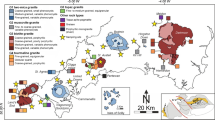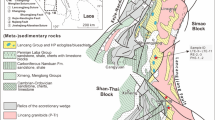Abstract
A wide range of trace elements have been analysed in mantle xenoliths (whole rocks, clinopyroxene and amphibole separates) from alkaline lavas in the Eastern Carpathians (Romania), in order to understand the process of metasomatism in the subcontinental mantle of the Carpatho-Pannonian region. The xenoliths include spinel lherzolites, harzburgites and websterites, clinopyroxenites, amphibole veins and amphibole clinopyroxenites. Textures vary from porphyroclastic to granoblastic, or equigranular. Grain size increases with increasing equilibrium temperature of mineralogical assemblages and results from grain boundary migration. In peridotites, interstitial clinopyroxenes (cpx) and amphiboles resulted from impregnation and metasomatism of harzburgites or cpx-poor lherzolites by small quantities of a melt I with a melilitite composition. Clinopyroxenites, amphibole veins and amphibole clinopyroxenites are also formed by metasomatism as a result of percolation through fracture systems of large quantities of a melt II with a melanephelinite composition. These metasomatic events are marked by whole-rock enrichments, relative to the primitive mantle (PM), in Rb, Th and U associated in some granoblastic lherzolites and in clinopyroxene and amphibole veins with enrichments in LREE, Ta and Nb. Correlations between major element whole-rock contents in peridotites demonstrate that the formation of interstitial amphibole and clinopyroxene induced only a slight but variable increase of the Ca/Al ratio without apparent modifications of the initial mantle composition. Metasomatism is also traced by enrichments in the most incompatible elements and the LREE. The Ta, Nb, MREE and HREE contents remained unchanged and confirm the depleted state of the initial but heterogeneous mantle. Major and trace element signature of clinopyroxene suggests that amphibole clinopyroxenites and some granoblastic lherzolites have been metasomatized successively by melts I and II. Both melts I and II were Ca-rich and Si-poor, somewhat alkaline (Na > K). Melt I differed from melt II in having higher Mg and Cr contents offset by lower Ti, Al, Fe and K contents. Both were highly enriched in all incompatible trace elements relative to primitive mantle, showing positive anomalies in Rb, Ba, Th, Sr and Zr. They contrasted by their Ta, Nb and LREE contents, lower in melt I than in melt II. Melts I and II originate during a two-stage melting event from the same source at high pressure and under increasing temperature. The source assemblage could be that of a metasomatized carbonated mantle but was more likely that of an eclogite of crustal affinity. Genetic relationships between calc-alkaline and alkaline lavas from Eastern Carpathians and these melts are thought to be only indirect, the former originating from partial melting of mantle sources respectively metasomatized by the melts I and II.
Similar content being viewed by others
Author information
Authors and Affiliations
Additional information
Received: 17 March 1997 / Accepted: 14 July 1997
Rights and permissions
About this article
Cite this article
Chalot-Prat, F., Boullier, AM. Metasomatism in the subcontinental mantle beneath the Eastern Carpathians (Romania): new evidence from trace element geochemistry. Contrib Mineral Petrol 129, 284–307 (1997). https://doi.org/10.1007/s004100050338
Issue Date:
DOI: https://doi.org/10.1007/s004100050338




